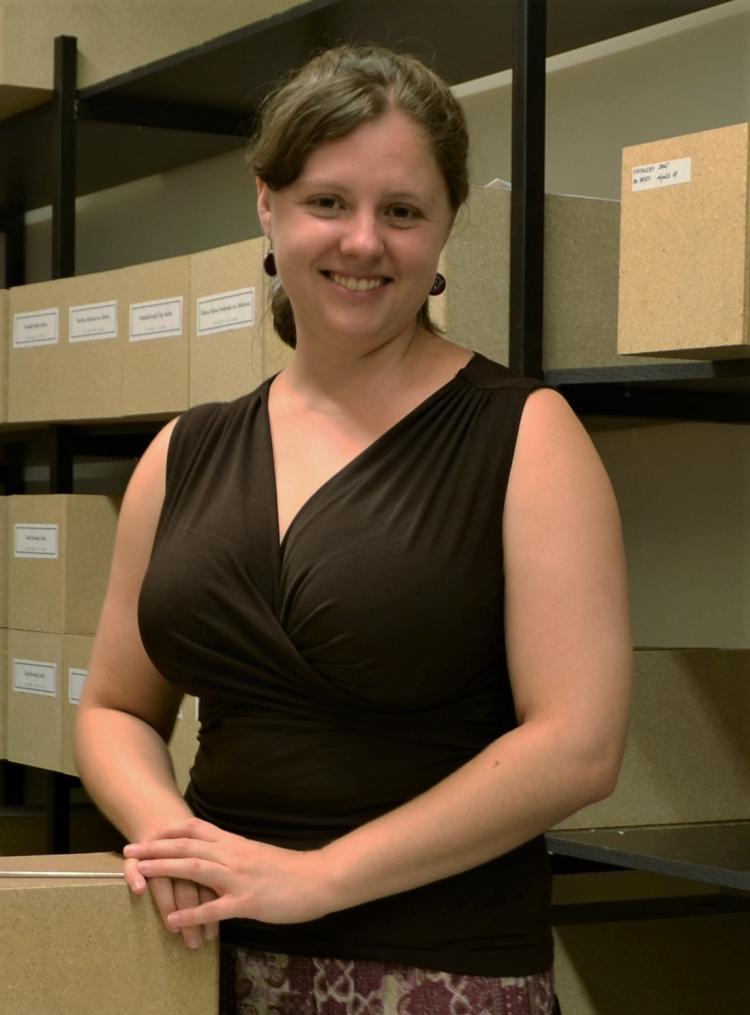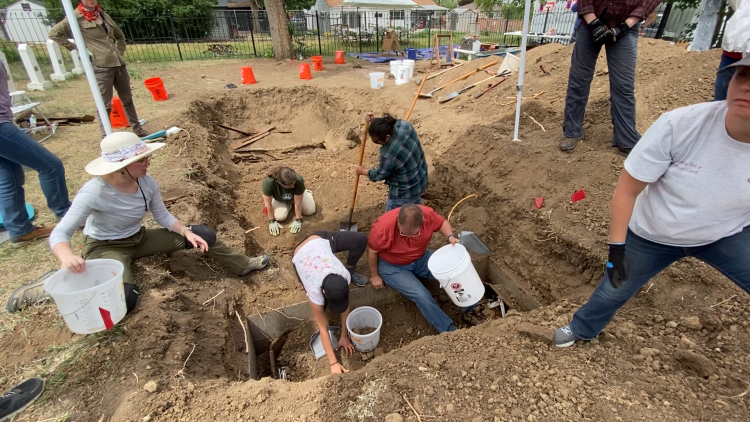62 nuns were buried in a historic Denver cemetery. This archaeologist is helping to move them
A metal plaque marked the casket of Sister Rosaline Hutchins who died and was buried in a cemetery at Loretto Heights in Denver in 1936. (Credit: Chris Daley/Mt. Olivet)
Lauren Hosek cradles a human jawbone in the palm of her gloved hand—it’s brown and covered in flecks of dirt.
Behind her, a team of archaeologists spreads out in a field not far from Pancratia Hall, a red-brick building constructed in 1929 in southwest Denver. Six or so students kneel in a hole about the size of a swimming pool, excavating a series of graves. They carefully pull away what’s left of wooden caskets and collect pieces of bone, including the mandible Hosek is now inspecting.
The researcher is a “bioarchaeologist” at CU Boulder who specializes in working with human remains. And, she learns, the bone she’s holding belonged to Sister Carmelita Hodapp, an educator and nun who died in Denver in 1909.
“I love teeth,” said Hosek, who will join the CU Boulder faculty in the fall as an assistant professor of anthropology. “They can tell us so much about the health of the body over time, but we can also see things like the way people tried to care for their bodies or even care for others.”
Hodapp was one of 62 women who were buried in this historic cemetery, once operated by a Catholic order called the Sisters of Loretto. All former nuns, the women died between 1898 and 1969. They came to Colorado from New York City, St. Louis and County Galway, Ireland. They taught math, music, art and more to everyone from the children of miners to college students.
On this day in July, they’re in the process of being moved. Because of impending development, the Sisters of Loretto decided to transfer the women’s remains to another nearby cemetery to ensure they can receive “perpetual care.” Hosek is part of a team led by Michala Stock at Metropolitan State University (MSU) of Denver overseeing the exhumation. Students from both MSU and CU Denver, and an incoming freshman at CU Boulder, participated in the effort.
Hosek, in particular, is collaborating with current members of the order to develop “osteobiographies” for the 62 nuns—essentially, telling the stories of their lives through the clues hidden in their bones.
Throughout the process, she and her colleagues will take pains to ensure they’re treating the nuns’ remains with respect. At least one representative from the Sisters of Loretto, for example, was on site at all times during the several week-long exhumation project. Once Hosek is finished analyzing the remains, the team will carefully place them into oak caskets for reburial.
“Being invited to join in the process of exhuming and reinterring these 62 sisters has been an amazing, humbling and, ultimately, educational experience for me and our team of volunteers,” Stock said. “We’ve kept in the forefront of our minds that these are people we are working with, and that death does not diminish or negate the fundamental respect and reverence that everyone deserves.”
Pioneering sisters
Sister Mary Nelle Gage, a current member of the Sisters of Loretto, joined Stock, Hosek and their colleagues at the site—the former campus of a Catholic school called Loretto Heights College, which became part of Regis University in 1988. She said she’s grateful that, in their deaths, the 62 women can continue to do what they were passionate about in life: teach.
For her, the project is a personal one. The Sisters of Loretto were founded in Maryland in 1812 but today include fewer than 85 nuns, Gage said.
“These nuns are the shoulders on which our community stands,” Gage said.
Mother Pancratia Bonfils, for example, traveled to Denver by train and stagecoach in 1868 and later helped to found Loretto Heights College. Sisters Miriam Judd and Vivian Edelin both earned doctorates in the early 20th century when academia was an arena dominated by men. They died within two years of each other in 1939 and 1941.
Gage added that even the cemetery itself has been an important fixture of this neighborhood in southwest Denver for decades.
“[Community members] have memories of walking past the cemetery and being scared to death, or of coming in and finding solace here,” she said.
Osteobiographies
Hosek wants to pay tribute to that history.
In the fall, she’s teaching a new course at CU Boulder called Advanced Osteology that will help students identify human remains like the ones at Loretto Heights. Hosek noted you can learn a lot about a person’s life, and the society around them, from their teeth and bones.
Take the history of dentistry: In the 19th century, this profession was in the middle of a major upheaval, Hosek said, evolving from an ad hoc and sometimes brutal undertaking into a more modern and regulated medical field. The nuns’ remains, Hosek said, provide a window into how dentistry and dental care were changing across that time period and after.
“It was coming out of what you could call a Dark Ages where anyone could be a dentist and pull teeth with the right tools,” Hosek said. “You had umbrella makers and silversmiths pulling teeth and plugging fillings. That was all starting to shift by the early- to mid-19th century.”
Many of the Sisters of Loretto, including Sister Carmelita Hodapp, came to Colorado in an attempt to recover from bouts of bad health. Hosek is hoping to find hints of these illnesses in the women’s remains—diseases such as tuberculosis and osteomalacia, caused by vitamin D deficiency, can leave marks behind on a person’s skeleton.
Hosek will examine the remains until around Aug. 22, when the 62 nuns are slated to be reinterred during a ceremony at Mt. Olivet Catholic Cemetery in Wheat Ridge.
Like Gage, the bioarchaeologist is grateful for the chance to revisit how these women helped to shape Denver more than a century ago.
“Sister Mary Nelle kept saying these women were educators, and the idea of them continuing to educate the Sisters of Loretto, the public and even my own students is really important,” Hosek said. “I want to honor that spirit.”





